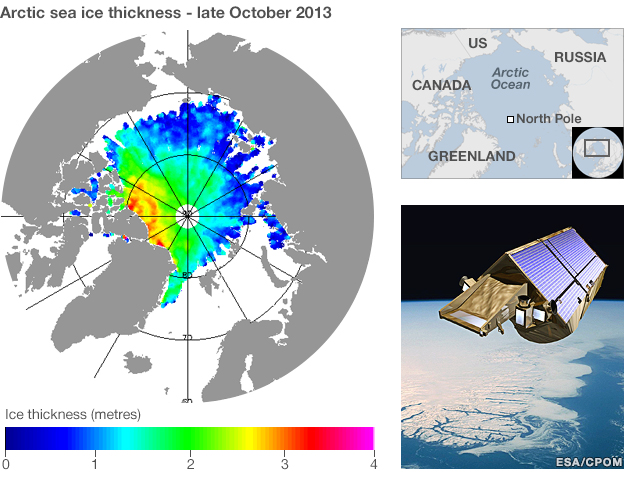The Beeb has surprised today in reporting that Arctic sea ice VOLUME grew a stunning 50%, from 6000 cubic kilometers to approx. 9000 cubic kilometers, from 2012 to 2013, this according to measurements made by the Cryosat probe of the European Space Agency.
Yet another argument of the warmists is melting away.
Are sea ice models next in line to be embarrassed?Data from Europe's Cryosat spacecraft suggests there were almost 9,000 cu km of ice at the end of this year's melt season. This is close to 50% more than in the corresponding period in 2012.
Whenever sea ice area did not cooperate, the warmists always insisted that we needed to look at volume - that, they told us, was the real barometer. But now we are seeing that Arctic sea ice volume is also no longer cooperating. According to Rachel Tilling from the UK's Nerc Centre for Polar Observation and Modelling (CPOM).
Of course scientists and the BBC are scrambling to play down the new development, saying that the Arctic ice volume is still very low.One of the things we'd noticed in our data was that the volume of ice year-to-year was not varying anything like as much as the ice extent - at least for the years 2010, 2011 and 2012.
This is why we're really quite surprised by what we've seen in 2013. We didn't expect the greater ice extent left at the end of the summer melt to be reflected in the volume. But it has been. And the reason is related to the amount of multi-year ice in the Arctic."
They blame "wind patterns" for not spreading the ice out more, and thus preventing it from melting more during the 2013 summer. Yet, we recall that in 2007 and 2012 the same scientists immediately blamed global warming for the rapid melt, and not winds, which had been clearly at play. Little wonder the public is losing confidence.
More old ice
The Beeb adds: "Part of this stronger performance can be put down to the greater retention of older ice."
Interestingly scientists say thickness/volume is the best metric with which to judge the health of the ice pack. Perhaps then we should see more plots of this metric in the future instead of the at-times meaningless sea ice area extents.




The situation in the Arctic is a bit more complicated.
First, there is the relentless cold of 2013:
[Link]Second, there is the feeding of Earth's Northern Temperate Zone ocean heat to the Arctic wolves:
[Link]That ocean heat melts the edges of the Arctic Ice Pack, but then that heat also escapes out the top to space.
The net result is to lower the overall heat supply that moderates the Temperate and Mediterranean climate systems. That's how you get snow on the Sphinx.
The batteries are getting drained.